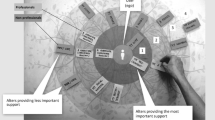Abstract
Background: Deinstitutionalisation has led to persons with serious mental illness spending most of their time outside psychiatric institutions. Not much is known about their social life. The paper presents the results of structured interviews with non-institutionalised persons with schizophrenia about treatment, care and social network. The network data are analysed from three perspectives: finding predictors of the number and of the quality of social contacts, and establishing the respective variables that characterise persons with high, and those with low, scores on both the quantity and quality dimensions of social integration. Methods: Random samples of persons with schizophrenia receiving outpatient services in ten psychiatric centres in the four Nordic countries were interviewed. The following instruments were used: Interview Schedule for Social Interaction (ISSI), Camberwell Assessment of Needs, Lancashire Quality of Life Profile, General Assessment of Functioning (GAF) and Brief Psychiatric Rating Scale (BPRS), in addition to a checklist covering the utilisation of different services. The ISSI provided the main data for this paper. A restricted number of possible predictors were used in General Linear Model (GLM) factorial analysis and discriminant analysis. Results: A total of 418 persons took part in the study. The overall participation rate was 55%. Social integration in terms of number of contacts was related to a high GAF score, few BPRS negative and hostility symptoms, having contact with user organisations and living in urban (in contrast to rural) areas. Availability of emotional relations was predicted by female sex, low scores on the BPRS hostility dimension, high GAF score, having contact with one's family more than once a month, and living in urban areas. Work, adequate leisure activities and GAF score discriminated between the best and worst integrated groups. Conclusions: Living in urban areas, being female, having a high GAF score and low scores on hostility predicted better integration in terms of number of contacts and emotional relations.
Similar content being viewed by others
Author information
Authors and Affiliations
Additional information
Accepted: 2 October 2000
Rights and permissions
About this article
Cite this article
Sörgaard, K., Hansson, L., Heikkilä, J. et al. Predictors of social relations in persons with schizophrenia living in the community: a Nordic multicentre study. Soc Psychiatry Psychiatr Epidemiol 36, 13–19 (2001). https://doi.org/10.1007/s001270050285
Issue Date:
DOI: https://doi.org/10.1007/s001270050285



